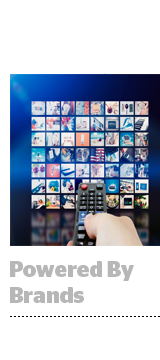
In Netflix’s original film “Like Father,” the cruise line Royal Caribbean literally sets the stage for the movie – the brand is actually part of the story.
While this sort of product placement isn’t new, it’s coming at a time when content providers are trying to decrease their ad loads and experimenting with new ways to incorporate ads.
Research from PQ Media reports that 84% of millennials don’t “like or trust” traditional marketing. This disillusionment has given rise to a trend that Ian Schafer, co-founder and former CEO of the marketing agency Deep Focus, calls “brands underwriting content.”
“This is happening more and more as publishers don’t have the financing or capital to underwrite a ton of original programming,” Schafer told AdExchanger. “Increasingly, they’re hatching ideas with brands to create new forms of branded entertainment.”
Ninety-one percent of Hulu originals and 74% of Netflix originals contain brand integrations, according to PQ Media. And Hulu says its overall sponsorship deals have increased 30% year over year.
While the core tenets of product placement haven’t changed much over the last few decades, brands have become increasingly entwined in every step of the production process. In some cases, a show might not even get off the ground without a brand attached.
“There are companies that we work with that have direct relationships with showrunners,” said Erin Vogel, SVP of creative lead branded content at Publicis-owned media agency Spark Foundry. “When we get pitched shows before they’re greenlit, we get established networks or studios that will bring us a show and say, ‘This doesn’t have any brands integrated. We might not even greenlight them if we can’t find a brand to be associated with them.’”
Hulu’s VP of integrated marketing, Nicole Sabatini, says that brand integration is more critical than ever to the company’s success.
“Not only can we work with brands to integrate them into our storylines, but because we have an ad-supported platform, we can then amplify that with other elements surrounding the show,” she told AdExchanger, referring to the targeted ad units Hulu can create.
In the first season of “The Runaways,” Sabatini oversaw an integration with Lyft. The deal was inspired by the show’s teen actors, who shuttled themselves around the set using the ride service. Hulu then came to Lyft with an offer that it was happy to engage in, since it wanted to be in “culturally relevant spaces,” Sabatini said.
Hulu similarly integrated McDonald’s into a season plotline of “The Mindy Project,” which worked out very organically, as its creator, Mindy Kaling, apparently loves McDonald’s.
A spokesperson for Hulu told AdExchanger that brand integrations have “delivered an 89% increase in purchase intent among viewers and a 74% increase brand awareness in comparison to a traditional 30-second spot.”
But these product placements are largely the result of in-person negotiations. Can automation – which has had a growing role in media buying – change the nature of product placements?
Video ad tech company TripleLift has a product designed to help brands place different products into content based on user data. For example, a bottle of Sprite in an episode of “Stranger Things” might appear to one viewer as a bottle of Dr. Pepper, depending on whom an advertiser is trying to target.
“The technology for programmatic product placement is already there,” said TripleLift CEO and co-founder Ari Lewine. “it’s just a matter of time before forward-leaning media companies, particularly those pursuing vertical integration strategies, which own content and distributions, start to invest in these kinds of solutions.”
Lewine said this vertical integration is essential in order for programmatic product placement to work, because user subscription data is needed to serve ads that are relevant to them.
Both Lewine and TripleLift co-founder Shaun Zacharia said the main challenge in automated product placement is not the technology, but MVPDs’ reticence to sign on to something that manipulates content. This could mean legal battles around licensing fees and potentially mountains of paperwork.
Zacharia told AdExchanger that TripleLift just finished a road show with “every major programmer in the market,” including the “Disney–ABCs, Foxes, Hulus and AT&Ts of the world.” The company’s ad insertion tech is currently being tested in a “closed beta” program with a small number of programmers that Zacharia could not disclose.
Vogel and Lewine agree that brand integrations will become much more common in content integration, especially as audiences become more jaded with traditional tactics.
“I think you’ll see deeper integrations,” Vogel said.” You’ll see more brands creating entertainment themselves, bringing showrunners and directors to build around that.”
This post was syndicated from Ad Exchanger.


More Stories
SCPI launches Mind Control initiative to tackle pet persuasion
Fanta’s Famous Jingle Is Back With New ‘Wanta Fanta’ Remix
GSTV Wants To Turn Gas Stations Into A Video Ad Marketplace